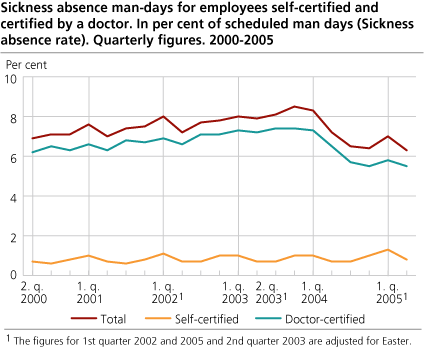Content
Published:
This is an archived release.
Continued decrease in sickness absence
The total sickness absence continues to decrease and fell from 7.2 per cent in the second quarter of 2004 to 6.3 per cent in the second quarter of 2005. The recent decrease is mainly attributable to a reduction in the duration of sickness absence.
Absence certified by a doctor fell from 6.5 to 5.5 per cent, while self-certified absence increased from 0.7 to 0.8 per cent in the same period. We estimate that the sickness absence rate would have been approximately 0.1 percentage points lower in the second quarter of 2004 if Easter had occurred in the first quarter of the year. The figures are taken from the central statistics on sickness absence.
The sickness absence has fallen by 12 per cent from the second quarter of 2004 to the second quarter of 2005, and by 10 per cent from the second quarter of 2001 to the second quarter of 2005.
Fall in long-term sickness absence
30.2 per cent of the sickness absence man-days certified by a doctor in the second quarter of 2005 lasted throughout the quarter. This is a decrease from 35.6 per cent in the second quarter of 2004. Self-certified sickness absence accounted for 12.7 per cent of the total sickness absence, an increase from 9.7 per cent in the second quarter of 2004. Sickness absence man-days as a proportion of scheduled man-days fell more than the number of employees on sick leave as a proportion of all employees. This indicates that the recent decrease in sickness absence is mainly attributable to a reduction in the duration of sickness absence.
Across all industries
The decrease in sickness absence was largest in construction, manufacturing and mining, and transport and communication. The sickness absence rate fell from 7.3 to 6.1 per cent in construction, from 7.2 to 6.0 in manufacturing and mining and from 7.8 to 6.7 per cent in transport and communication. The decrease was lowest in public administration and education.
Largest decrease in Østfold and Finnmark
Østfold and Finnmark had the largest decrease in sickness absence from the second quarter of 2004 to the second quarter of 2005. The sickness absence rate in the two counties fell by 1.5 and 1.4 percentage points, respectively. With a decrease of 0.7 percentage points, Aust-Agder had the lowest decrease. The sickness absence rate is lowest in Rogaland at 4.1 per cent and highest in Finnmark at 6.9 per cent.
Decrease in all institutional sectors
The sickness absence in local government fell from 8.8 to 7.9 per cent from the second quarter of 2004 to the second quarter of 2005. In central government (including state hospitals) and the private sector the sickness absence fell from 6.6 to 6.0 per cent and 6.8 to 5.9 per cent, respectively.
The following data are based on figures for sickness absence certified by a doctor, as the survey on self-certified absence does not contain data on sickness absence by age.
Decrease in all age groups
The fall in sickness absence was evident among men and women of all age groups. For women the largest decrease took place in the age group 60-64 years, while the smallest decrease took place in the age group 30-34 years. For men the largest decrease took place in the age group 30-34 years, while the smallest decrease took place in the age group 20-24 years.
Tables:
- Table 1 Sickness absence man-days for employees self-certified and certified by a doctor. In per cent of scheduled man-days (Sickness absence rate). Quarterly figures. 2000-2005
- Table 2 Sickness absence man-days for employees self-certified and certified by a doctor, by sex. In per cent of scheduled man-days (Sickness absence rate). Quarterly figures. 2000-2005
- Table 3 Sickness absence man-days for employees self-certified and certified by a doctor, by industry and type of sickness absence. In per cent of scheduled man days (Sickness absence rate). Quarterly figures. 2000-2005
Contact
-
Arbeidsmarked og lønn
E-mail: arbeidsmarked@ssb.no
-
Unn H. Høydahl
E-mail: unnh.hoydahl@ssb.no
tel.: (+47) 40 90 23 77

